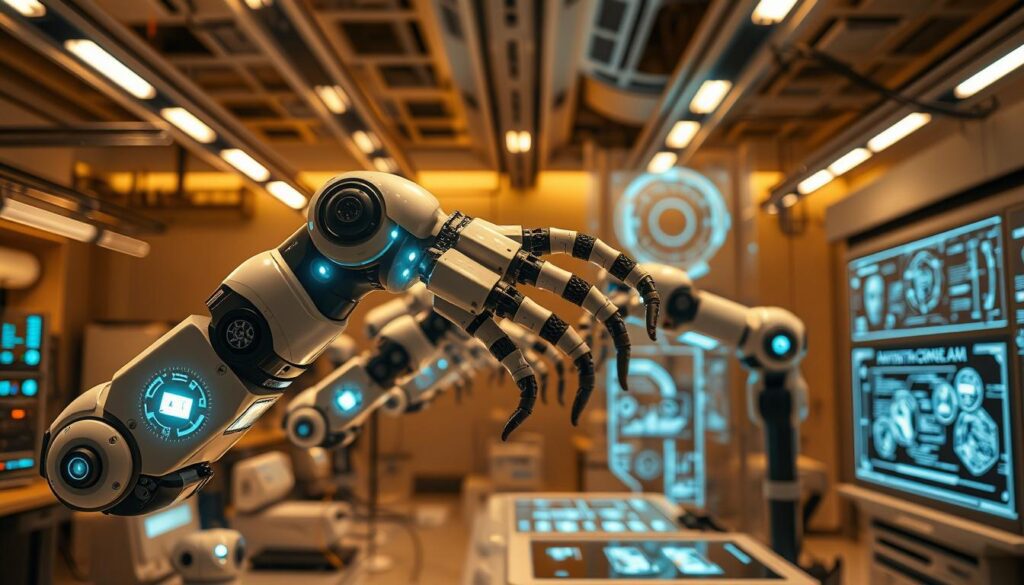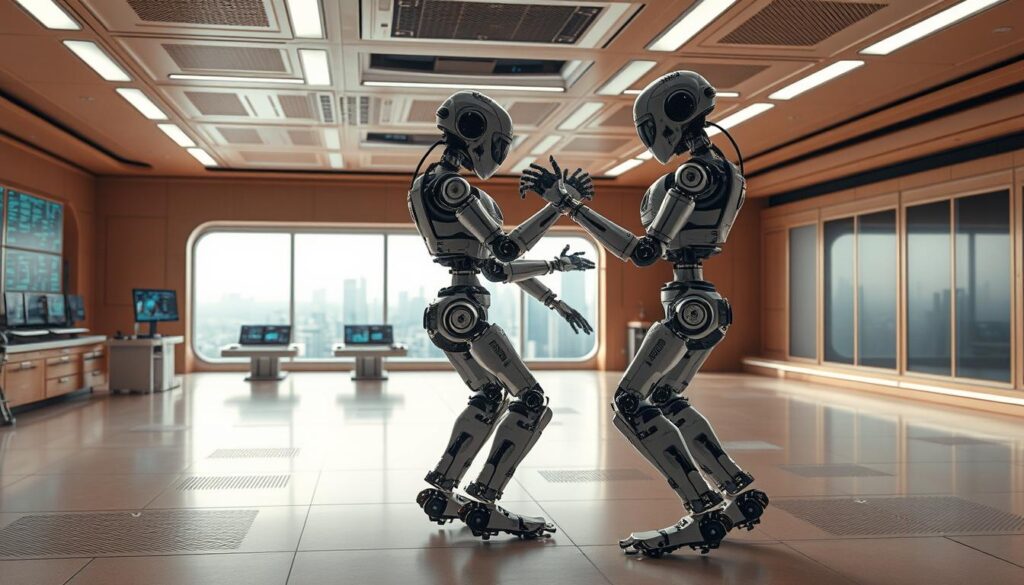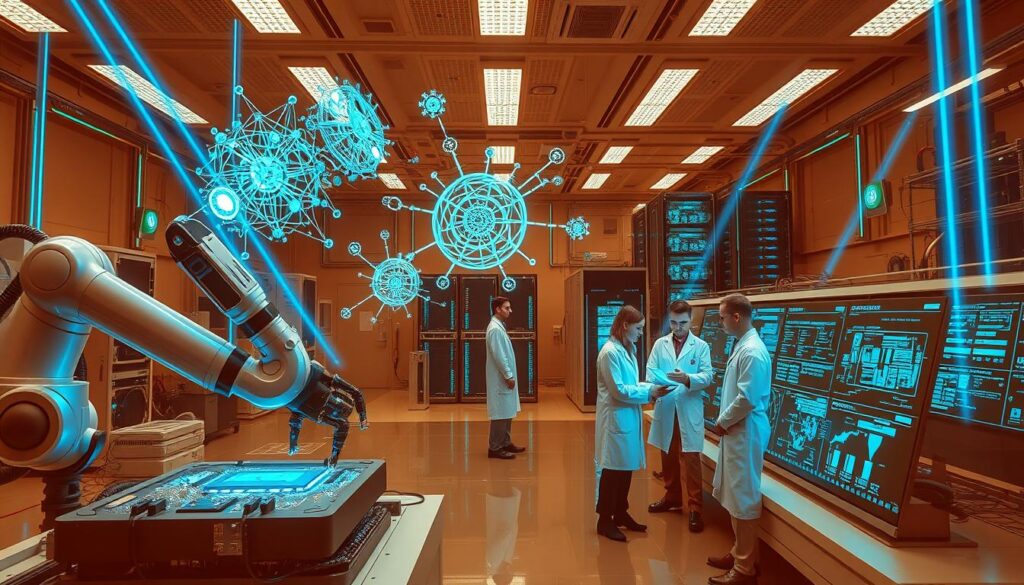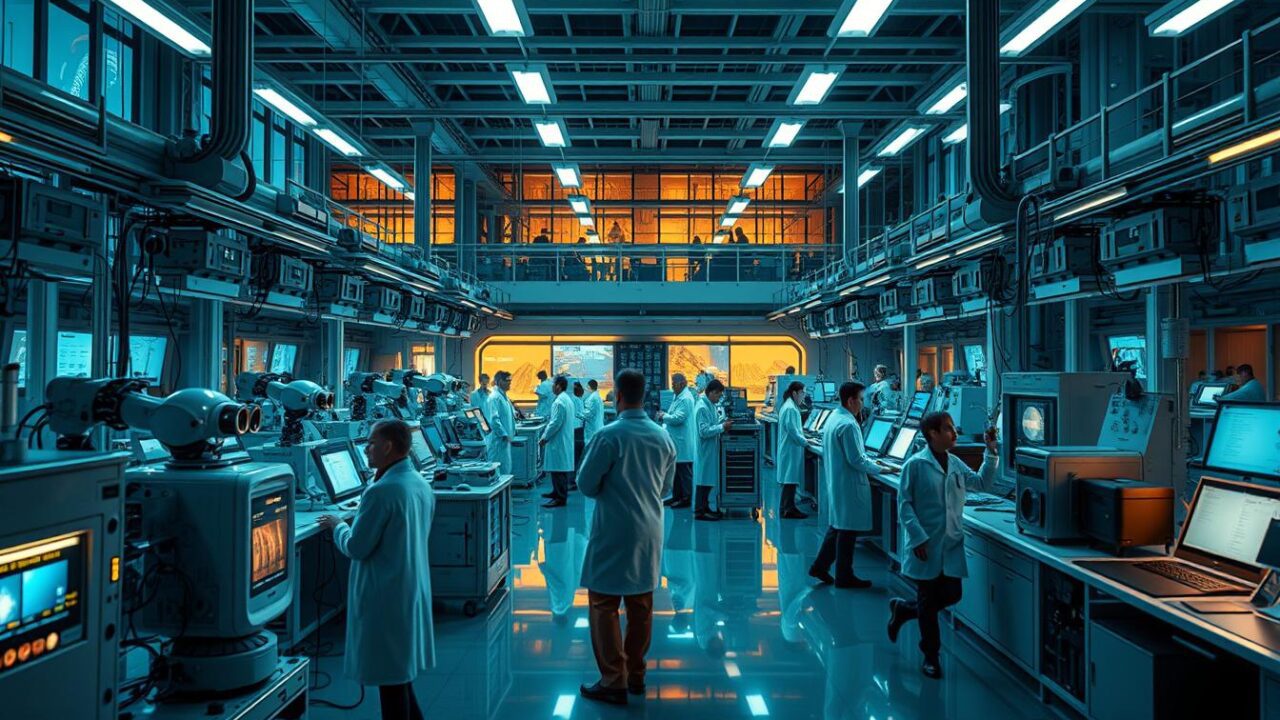Have you ever wondered how industries are evolving at such a rapid pace? The answer lies in the seamless integration of artificial intelligence and advanced machine learning techniques. These technologies are not just buzzwords—they are reshaping the way we approach challenges and opportunities.
From manufacturing to healthcare, systems powered by cutting-edge technology are driving efficiency and innovation. For instance, automated processes in logistics have significantly reduced errors and improved delivery times. Similarly, in healthcare, intelligent systems assist in diagnostics, ensuring faster and more accurate results.
This transformation is not just about automation; it’s about creating smarter, more adaptive solutions. By leveraging data and advanced models, industries are unlocking new possibilities and setting the stage for a more innovative future.
Key Takeaways
- Modern systems are revolutionizing industries through artificial intelligence and machine learning.
- These technologies enhance efficiency and accuracy in processes like logistics and healthcare.
- Innovation is driven by adaptive solutions that leverage data and advanced models.
- Industries are unlocking new possibilities for future growth and development.
- The integration of technology is setting a new standard for problem-solving and innovation.
Innovative Robotics and AI Integration

Innovative technologies are transforming how humans and machines collaborate. The seamless integration of robotics and artificial intelligence is driving significant advancements across industries. From manufacturing to healthcare, these technologies are enabling smarter, more efficient processes.
Emerging Technology Trends in Robotics
One of the most notable trends is the rise of computer vision and deep learning. These technologies allow machines to interpret visual data with remarkable accuracy. For example, in manufacturing, robots equipped with advanced sensors can identify defects in products faster than human inspectors.
Another key development is the use of reinforcement learning. This technique enables machines to learn from their environment and improve over time. In healthcare, robots are assisting surgeons by providing real-time data and precision during complex procedures.
Enhancing Human-Machine Collaboration
Companies like Amazon and BMW are leading the way in human-machine collaboration. Their use of collaborative robots, or cobots, has revolutionized workflows. These cobots work alongside human teams, enhancing productivity and reducing errors.
Smart algorithms play a crucial role in this integration. They enable machines to make dynamic decisions based on real-time data. This capability is particularly valuable in industries like logistics, where quick responses are essential.
As these technologies continue to evolve, they are creating a more intuitive environment for industrial applications. The future of human-machine collaboration looks promising, with endless possibilities for innovation and growth.
Understanding AI Agents in Robotics

From rule-based systems to adaptive agents, robotics has undergone a significant transformation. Today, AI agents are at the forefront of this evolution, enabling machines to perform complex tasks with greater autonomy and precision. These agents are not just tools; they are intelligent systems capable of learning, adapting, and making decisions in dynamic environments.
Defining the Role of AI Agents
An AI agent is a sophisticated system designed to perceive its environment, process data, and take actions to achieve specific goals. Unlike traditional robots, these agents operate with a high degree of autonomy. They can analyze sensory inputs, make decisions, and learn from their experiences. This capability is what sets them apart from earlier, rule-based systems.
For example, in autonomous vehicles, agents use computer vision and sensor data to navigate roads safely. In healthcare, they assist in surgeries by providing real-time insights and precision. These applications highlight the transformative potential of AI agents across industries.
The Evolution of Autonomous Decision-Making
The journey from rigid programming to adaptive decision-making has been remarkable. Early robots relied on predefined rules, limiting their ability to handle unexpected situations. Modern agents, however, use reinforcement learning and advanced models to improve their performance over time.
Take autonomous vehicles as an example. They learn from millions of miles of driving data, enabling them to make safer and more efficient decisions. Similarly, in manufacturing, agents optimize production lines by analyzing real-time data and predicting potential issues.
“AI agents are not just tools; they are partners in innovation, capable of transforming industries through intelligent decision-making.”
This evolution is not just about technology; it’s about creating systems that can adapt to the complexities of the real world. As we continue to refine these agents, their potential to drive innovation and efficiency will only grow.
Key Technologies Powering Robotic Labs

At the heart of robotic innovation are cutting-edge technologies that drive efficiency and precision. These advancements are not just reshaping industries but also redefining what machines can achieve. From machine learning to deep learning, the tools behind modern robotics are both powerful and versatile.
Machine Learning and Deep Learning Innovations
Machine learning forms the backbone of many robotic systems. It enables machines to learn from data, improving their performance over time. For example, deep neural networks are used in image recognition, allowing robots to identify objects with remarkable accuracy.
Another critical technique is reinforcement learning. This approach allows machines to learn by interacting with their environment. Autonomous vehicles, for instance, use this method to navigate complex road conditions safely.
Enhancing Capabilities with Computer Vision
Computer vision is another game-changer. It enables robots to interpret visual data, making them more adaptable. In manufacturing, robots equipped with this technology can detect defects in products faster than human inspectors.
Data processing also plays a vital role. By analyzing vast amounts of information, robots can make smarter decisions. This capability is crucial in fields like healthcare, where precision is paramount.
Real-World Applications
These technologies are already making an impact. In precision manufacturing, robots optimize production lines by analyzing real-time data. In healthcare, they assist in surgeries, providing real-time insights and improving outcomes.
“The integration of machine learning and deep learning is transforming robotics, enabling smarter and more efficient systems.”
As we continue to innovate, the potential for these technologies is limitless. Continuous research and development will drive further advancements, shaping the future of robotics and beyond.
Exploring: Robotic labs + better AI algorithms + agents to help with ideat
Software systems are playing a pivotal role in advancing machine capabilities. These tools are not just supporting intelligent agents; they are transforming how we design, manage, and optimize them. From visual development environments to chat-based creation tools, the barriers to implementing advanced systems are rapidly diminishing.
Optimizing Algorithm Performance
One of the key functions of these systems is optimizing algorithm performance. By leveraging machine learning techniques, they enable real-time processing and decision-making. For instance, platforms like TensorFlow and PyTorch have democratized the creation of intelligent agents, allowing users to build models with minimal coding expertise.
These systems also enhance the efficiency of tasks. In industries like logistics, they process vast amounts of data to streamline operations. This capability ensures that machines can adapt to dynamic environments, improving overall productivity.
Lowering Barriers with Visual and Chat-Based Tools
Visual and chat-based development tools are making it easier for non-experts to create functional agents. Platforms like Microsoft’s Power Virtual Agents allow users to design conversational agents without deep technical knowledge. This approach is empowering teams across industries to innovate without relying on specialized developers.
For example, in customer service, these tools enable businesses to deploy chatbots that handle inquiries efficiently. This not only reduces operational costs but also enhances user experience by providing instant responses.
Integration Between Software and Physical Components
The integration of sophisticated software with physical robotic components is another game-changer. This synergy enhances operational workflows and fosters better human-machine collaboration. Companies like Amazon use such systems to optimize warehouse operations, where robots and humans work seamlessly together.
“The future of intelligent systems lies in their ability to adapt and learn from their environment, driving innovation across industries.”
As these technologies evolve, they are setting the stage for even more advanced applications. From healthcare to manufacturing, the potential for growth is immense. The focus now is on refining these systems to handle increasingly complex challenges.
Real-World Applications of AI-Enhanced Robotics
From factory floors to operating rooms, intelligent machines are making a significant impact. These systems are not just tools; they are partners in innovation, transforming industries with precision and efficiency. Whether it’s automating complex tasks or enhancing human capabilities, the applications are vast and impactful.
Industrial Automation and Collaborative Robots
In industrial settings, collaborative robots, or cobots, are revolutionizing workflows. Companies like BMW and Amazon are leading the way. These machines work alongside human teams, improving productivity and reducing errors. For example, Amazon’s warehouses use cobots to streamline order processing, achieving faster delivery times.
These systems leverage machine learning to adapt to dynamic environments. They analyze real-time data to optimize processes, ensuring efficiency and accuracy. This approach not only enhances productivity but also ensures workplace safety by handling repetitive or hazardous tasks.
Transforming Healthcare with Precision Robotics
Healthcare is another field where intelligent systems are making waves. Precision robotics, like the da Vinci surgical system, enable minimally invasive procedures. These machines provide surgeons with enhanced control and real-time data, improving patient outcomes.
For instance, the da Vinci system uses computer vision and advanced sensors to assist in complex surgeries. This technology reduces recovery times and minimizes risks, showcasing the potential of intelligent systems in healthcare. According to research, such systems have improved surgical accuracy by up to 30%.
“The integration of intelligent systems in healthcare is not just about technology; it’s about saving lives and improving outcomes.”
These advancements highlight the cross-industry impact of AI-enhanced robotics. From manufacturing floors to hospital operating rooms, the benefits are clear: cost savings, productivity gains, and enhanced accuracy. As we continue to innovate, the potential for these systems to address complex challenges will only grow.
For more insights into how intelligent systems are transforming industries, explore our detailed guide on AI use cases and applications.
Advancements in Machine Learning and Sensor Technologies
The fusion of advanced sensors and machine learning is reshaping how machines perceive and interact with the world. These technologies are not just enhancing accuracy but also enabling systems to adapt to dynamic environments. From object recognition to real-time decision-making, the possibilities are expanding rapidly.
Next-Generation Computer Vision Systems
Modern computer vision systems are at the forefront of this transformation. They enable machines to interpret visual data with remarkable precision. For example, autonomous vehicles use these systems to navigate complex road conditions safely.
In manufacturing, robots equipped with advanced sensors can detect defects in products faster than human inspectors. This capability not only improves efficiency but also ensures higher quality standards. According to recent research, such systems have reduced error rates by up to 30% in some industries.
Another breakthrough is the integration of deep learning models. These models allow machines to learn from vast amounts of data, improving their performance over time. For instance, in healthcare, imaging systems powered by these models assist in diagnosing diseases with greater accuracy.
“The convergence of sensor technology and machine learning is creating smarter, more responsive systems that are transforming industries.”
High-quality data plays a crucial role in optimizing sensor performance. Refined algorithms ensure that machines can process information efficiently, even in challenging environments. This synergy is driving innovations across fields like logistics, healthcare, and autonomous navigation.
Looking ahead, experts predict significant advancements in this realm. Initiatives like the U.S. Department of Defense’s Artificial Intelligence and Next Generation Distributed Command and Control project are paving the way for future breakthroughs. These efforts highlight the potential of these technologies to address complex challenges and improve operational efficiency.
In summary, the integration of advanced sensors and machine learning is revolutionizing how machines operate. By enhancing accuracy, adaptability, and efficiency, these innovations are setting the stage for a smarter, more connected future.
Ethical and Technical Challenges in AI Robotics
The rapid integration of AI into robotics brings both opportunities and challenges. While these technologies promise to revolutionize industries, they also raise critical ethical and technical questions. Addressing these issues is essential to ensure responsible and sustainable innovation.
Addressing Data Bias and Ensuring Transparency
One of the most pressing ethical challenges is data bias. AI systems rely on vast amounts of data to learn and make decisions. However, if this data is biased, the outcomes can be unfair or discriminatory. For example, the Microsoft Tay incident highlighted how biased data can lead to unintended consequences.
Transparency is another key concern. Many AI models, especially those using deep learning, operate as “black boxes.” This lack of clarity makes it difficult to understand how decisions are made. Researchers are now focusing on developing explainable AI to address this issue.
According to a study published in 2023, improving transparency in AI algorithms is crucial for building trust. “Without transparency, users cannot fully understand or trust the decisions made by these systems,” says Dr. Anh Nguyen, a leading expert in the field.
Overcoming Hardware and Energy Constraints
Technical challenges also play a significant role in limiting the potential of AI robotics. Hardware limitations, such as processing power and storage capacity, can hinder performance. For instance, autonomous vehicles require advanced sensors and real-time data processing, which demand significant resources.
Energy consumption is another major constraint. High-performance systems often require substantial power, making them less sustainable. Researchers are exploring energy-efficient designs and alternative power sources to mitigate this issue.
Current efforts, like the U.S. Department of Defense’s Artificial Intelligence and Next Generation Distributed Command and Control project, aim to address these challenges. By combining advanced hardware with optimized algorithms, they are paving the way for more efficient systems.
“The future of AI robotics depends on our ability to balance innovation with ethical responsibility.”
To learn more about the ethical considerations in AI, visit our detailed guide on AI ethics. This resource provides insights into the complexities of designing and implementing responsible AI systems.
In conclusion, addressing these challenges requires a collaborative approach. By fostering open-source research and cross-industry partnerships, we can create a fairer and more sustainable technological landscape. The journey ahead is complex, but with the right strategies, we can unlock the full potential of AI robotics.
Future Trends in AI, 5G, and Edge Computing
The convergence of AI, 5G, and edge computing is reshaping how systems operate in real-time. These technologies are not just enhancing efficiency but also enabling smarter, more responsive applications. From autonomous vehicles to smart cities, the possibilities are endless.
Autonomous Navigation and Real-Time Decision-Making
Autonomous navigation systems are benefiting significantly from these advancements. For example, self-driving vehicles use AI and 5G to process data in real-time, ensuring safer and more efficient travel. Edge computing plays a crucial role by reducing latency, allowing these systems to make split-second decisions.
In logistics, real-time decision-making is transforming operations. Companies are leveraging these technologies to optimize routes, reduce delivery times, and improve overall efficiency. According to industry forecasts, such systems will handle 15% of day-to-day decisions autonomously by 2028.
These advancements are not limited to transportation. Urban planning is also evolving, with smart cities using AI and 5G to manage traffic, energy, and public safety. The integration of these technologies is setting the stage for a more connected and efficient future.
“The future of intelligent systems lies in their ability to adapt and learn from their environment, driving innovation across industries.”
Edge computing is another game-changer. By processing data locally, it reduces dependence on centralized networks. This capability is particularly valuable in dynamic environments where quick responses are essential. For instance, in healthcare, edge computing enables real-time monitoring of patients, improving outcomes and reducing risks.
As we look ahead, the potential for these technologies is immense. From reshaping transportation to revolutionizing urban planning, the future is bright. For more insights into how these advancements are transforming industries, explore our detailed guide on AI-driven big ideas.
Case Studies: Success Stories and Innovative Projects in Robotic Labs
Real-world applications of intelligent systems are driving efficiency and innovation. From manufacturing floors to healthcare facilities, these technologies are delivering measurable results. Let’s explore some standout examples that highlight their transformative potential.
Breakthroughs in Manufacturing and Warehouse Automation
Companies like Amazon and BMW are leading the charge in automation. Amazon’s warehouses use collaborative robots, or cobots, to streamline order processing. These machines work alongside human teams, reducing errors and improving delivery times.
BMW has integrated advanced systems into its production lines. These tools analyze real-time data to optimize workflows, ensuring precision and efficiency. According to industry reports, such innovations have increased productivity by up to 20%.
“The integration of intelligent systems in manufacturing is not just about efficiency; it’s about creating safer and more sustainable operations.”
Innovative Healthcare and Service Robotics Initiatives
In healthcare, precision robotics like the da Vinci surgical system are transforming patient care. This technology enables minimally invasive procedures, reducing recovery times and improving outcomes. Research shows that such systems have enhanced surgical accuracy by 30%.
Service robotics is also making waves. For example, Shadecraft has developed the world’s first robotic shading system. This innovation combines AI and IoT technologies to provide adaptive solutions for outdoor spaces.
These case studies serve as blueprints for future projects. They demonstrate how collaboration between cross-functional teams and advanced tools can drive meaningful progress.
Conclusion
The future of intelligent systems is being shaped by groundbreaking advancements in technology. From enhanced decision-making to collaborative human-machine interaction, these innovations are transforming industries like manufacturing and healthcare. The integration of ethical considerations ensures responsible progress alongside technical growth.
Breakthroughs in learning models and sensor technologies are enabling machines to adapt to dynamic environments. These systems are not just tools; they are partners in innovation, driving efficiency and precision across diverse tasks. As we look ahead, trends like 5G and edge computing promise even greater potential.
To stay ahead, organizations must embrace these developments. Explore how AI recruitment tools are revolutionizing talent acquisition. The journey toward a smarter, more connected world is just beginning—let’s shape it together.
Want to hire me as a Consultant? Head to Channel as a Service and book a meeting.

